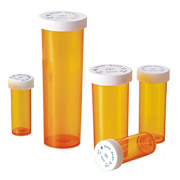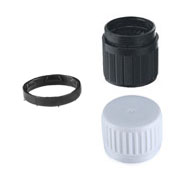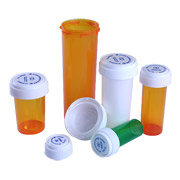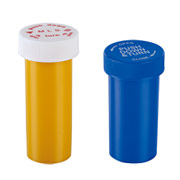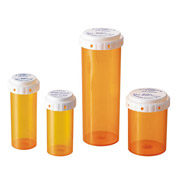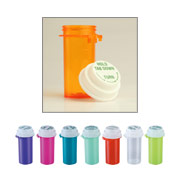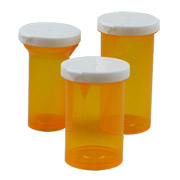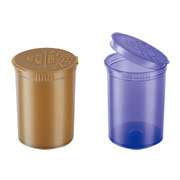Which Child-resistant Cap Is The Safest For Children?
First of all, child-resistant caps aren't Childproof completely, these caps aren't 100 percent effective!
Child-resistant packaging or CR packaging is special packaging used to reduce the risk of children ingesting dangerous items. This is often accomplished by the use of a special safety cap. It is required by regulation for prescription drugs, over-the-counter medications, pesticides, and household chemicals. In some jurisdictions, unit packaging such as blister packs is also regulated for child safety.
The U.S. Consumer Product Safety Commission has stated in a press release that "There is no such thing as child-proof packaging. So you shouldn't think of packaging as your primary line of defense. Rather, you should think of packaging, even child-resistant packaging, as your last line of defense."
>> From Wikipedia, the free encyclopedia
We assume that child resistant caps will protect our kids: After all, you have to push down, and turn to open it. You may think: "I'm an adult and even I have a hard time with these resistant caps sometimes. So how could a little kid open it?"
Children think it's candy, so they're going to swallow it and they're going to go after more. They will try their best to open it. Do you know how quickly children can open these vials or bottles? Some childrren can open them within 5 minutes!!!
What Does Child Resistant Mean?
Child-resistant packaging does not mean the packaging is child proof.
According to The Poison Prevention Packaging Act (PPPA). The act gives the US Consumer Product Safety Commission the authority to require child-resistant packaging on oral prescription medications as well as many household products. A child-resistant package is designed to be significantly difficult for children under 5 years of age to open or obtain a harmful amount of the contents within a reasonable time and not difficult for normal adults to use properly. To be child-resistant, 85% of tested children less than 5 years old must not be able to open the package within 5 minutes (this means 15% of children can open the package quickly), and 90% of tested adults must be able to open and properly close the package within 5 minutes.

Although this packaging has significantly decreased the number of unintentional poisoning deaths among children under 5 years old, poison centers across the nation received more than 1.3 million calls in 2003 about unintentional exposures. Over 40% of these calls were related to pharmaceutical ingestions by young children.
Kate Carr of Safe Kids said. "We don't want to make it impossible to open something. What we want to make sure is that kids can't get to medicine."
Sometimes, a child resistant cap is also called a safety cap. So actually, a child resistant cap is really not safe completely.
In 2005, media in Minneapolis, Minn, reported a tragic story about a 15-month-old child who died after ingesting the contents of a bottle that contained a compounded liquid formulation of flecainide.
The child had a congenital heart defect, which required her parents to administer 3 doses of the medication each day. Because she occasionally required an extra dose to control acute episodes of tachycardia, her parents carried the medication in the child's diaper bag. At a friend's home, the mother sat the child on the floor next to the diaper bag while she ran into the kitchen to get a bottle of milk from the refrigerator. In that short amount of time, her child was able to remove the cap from the bottle and drink the medication. The child was rushed to the hospital but could not be saved.
How easily a group of children between the ages of 3 and 8 years old could open the various child-resistant containers from a sampling of area pharmacies.
Types of Child Resistant Closure or Caps, Which Is More Safe?
This is onewo-piece plastic/plastic continuously-threaded closure.
A child resistant cap has an outer cap and an inner cap which engage by radial and linear contact to facilitate screwing and unscrewing the cap assembly. The closure is opened by pushing down on the closure and simultaneously turning it counter-clockwise.
The inner piece of the closure is made of polyethylene terephthalate (PET), which means it may be used with petroleum distillate or hypochlorite type products. The PET inner piece of the closure can be either clear or other color.
Child Resistant Caps With Tamper Evident Ring
This is a two-piece plastic/plastic continuously-threaded closure.
The closure is opened by pushing down on the closure and simultaneously turning it counter-clockwise.
The closure also offers tamper evidence through a breakaway drop ring on the closure. The breakaway drop ring will be removed from the closure once open the cap in right image and the ring can be seen in the right image.
This is one-piece plastic/plastic continuously-threaded closure.
In the child-resistant mode, the top of the closure is even with the top of the closure skirt. In the child-resistant mode, the closure is opened by pushing down on the closure and simultaneously turning it counterclockwise.
The closure is converted into its non-child-resistant mode by pushing down on the top of the closure, which will descend and lock into place about 4-5 mm from the top of the closure skirt. In the non-child-resistant mode, the closure is simply turned counterclockwise to open.
This is a one-piece plastic lug-bayonet closure.
The closure is opened by pushing down on the closure and simultaneously turning it counterclockwise.
The interior of the closure has 4 lugs which are 90o apart. The 4 lugs fit into the four “L” shaped bayonets on the container neck to keep the package closed. (Note: the number of lugs and bayonets varies with package size) .
It is a very popular cap at present.
Screw-Lock Cap
This is one-piece plastic lug-bayonet closure.
The closure is opened by pushing down on the closure and simultaneously turning it counterclockwise.
The interior of the closure has square lugs that fit into the “L” shaped bayonets on the container neck to keep the package closed.
Hold Tab Down And Turn Cap
This is a one-piece plastic reversible lug-bayonet closure that can be used in the non-child-resistant mode or in the child-resistant mode.
In the child-resistant mode, the closure is opened by holding down a tab on the container labeled “HOLD” and simultaneously turning the closure counterclockwise.
In the child-resistant mode, there are two lugs inside the closure and some continuous threads. In the child-resistant mode, one of the two lugs inside the closure fits into a bayonet attached to the tab on the container and the inner threads on the closure are screwed onto the outer threads of the container to keep the package closed.
In the non-child-resistant mode, the closure is simply turned counterclockwise to open it. In the non-child-resistant mode, the continuous threads on the outside of the closure are screwed into the inner threads on the container.
This closure is a one-piece plastic snap safe cap.
The closure is opened by aligning the tab on the closure with the arrow on the container and then pushing up on the tab.
The inside of the closure has a rectangular ridge in the same location as the tab. The rectangular ridge inside the closure fits into a groove in the container neck finish where the arrow is located, allowing the package to be opened.
It can't be opened if you don't align the tab on the closure with the arrow on the container.
Rx Squeeze Vial Cap
This is a one-piece plastic vial and snap closure attached with a captive hinge.
There is a child-resistant (CR) and non-child-resistant (NCR) version of this package.
The CR package is opened by simultaneously squeezing two specific points on the plastic vial, which causes the snap closure to flip open. The squeeze points are located at the top of the vial and are 1800 apart. Each squeeze point is designated by a set of 7 vertical ridges.
The non child resistant (NCR) version of the snap closure is opened by lifting the closure up.
>> More Caps Introduction From CPSC
What Can We Do To Prevent Accidental Poisoning From Medicines?
While it might seem impossible to keep your eye on an active and inquisitive toddler all the time, it is possible to stop them getting hold of medicines.
Keep all medicines out of sight and reach
Store medicines at least 1.5 metres (4 ft 11 inches) above floor level, preferably in a cupboard secured with a child-proof latch. Simply putting them in a high place where they can still be seen is not enough. Children, especially 3- and 4-year-olds, are very resourceful when it comes to finding ways of climbing.
If medicines need to be stored in a fridge, keep them out of sight in a plastic container with a tightly fitting lid. Place the container at the back of the fridge, but not next to the cooling element where they might freeze. Avoid storing medicines in the fridge door as they may be more easily seen and accessed by children.

If you tend to keep medicines in a prominent place as a reminder of when to take or give them, try using a note instead, or setting an alarm using our free MedicineList+ smartphone app.
Dispose of expired or unused medicines
Take any unused and out-of-date medicines to any pharmacy for free and safe disposal. Do not place them in your household garbage or flush them down the sink or toilet. Disposing medicines this way can harm the environment, and children and pets may easily get into bins.
Thankfully, most young children recover from poisonings with no lasting ill-effects, and deaths are very rare. However, if you suspect that a child has taken a medicine not intended for them, immediately ring the Poisons Information Centre on 13 11 26, or take them to the nearest hospital emergency department.
Conclusion
The child resistant caps aren't 100 percent effective, it's unrealistic to lock up our medication. So the easiest thing to do:
Take it off your nightstand, off the kitchen counter, and put it up and away where you can reach it but you're kids can't. And do that every time.
If your child does get into any medications, parents should call The Poison Help Line at 1-800-222-1222.

